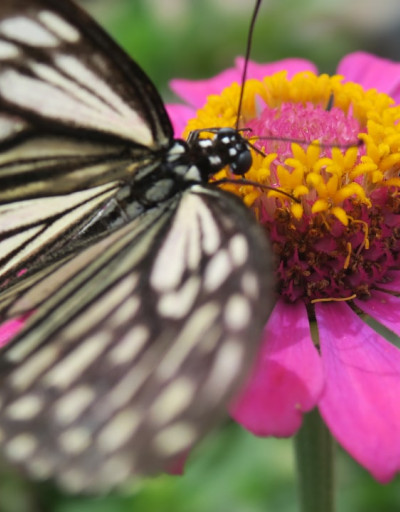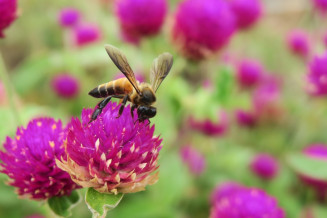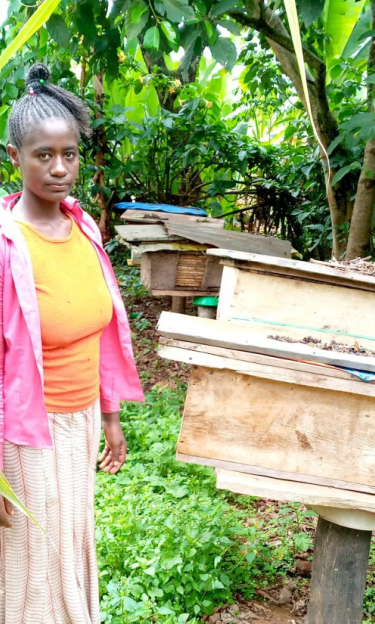Angelina Jolie launches Women for Bees' 2022 training programme in Cambodia
Angelina Jolie, Godmother of UNESCO x Guerlain Women for Bees programme, inaugurated first trainings in Cambodia for 11 women beekeepers with support of the UNESCO Office in Phnom Penh and in cooperation with the Maddox Jolie-Pitt Foundation, living in villages of Siem Reap, in the Tonle Sap Biosphere Reserve and in the Samlot district. Aggelina Kanellopoulou, from the first promotion of women beekeepers in France, joined to share knowledge and exchange best practices in beekeeping with the Cambodian women as part of the programme’s networking support desk. Cambodia is one of ten countries that are currently participating in the global programme.
In Cambodia, building on the scientific findings of UNESCO’s feasibility survey on the beekeeping ecosystem at the Tonle Sap Biosphere Reserve, the Women for Bees programme focuses on four types of training. Two six-month trainings for women aim to introduce beekeeping with the native Asian honeybee (Apis cerana) and stingless bees (Meliponini). Women who take part in the trainings receive adapted, local hives and material as well as a technical support for their beekeeping activities.
Another ongoing training aims at capacitating local tourist guides, including women, in apitourism and “bee-watching”, leveraging the importance of native bees in Khmer history and the potential of the Asian giant honeybee (Apis dorsata) for ecotourism.
The fourth training is directed at honey hunters and communities. It seeks to raise awareness about good practices in honey hunting, and to introduce sustainable beekeeping of the Asian giant honeybee on “rafters“. In the long run, this would allow multiple honey harvests without destroying the nests, therefore contributing to the conservation of the species.
The Tonle Sap Biosphere Reserve, designated in 1997 as a biosphere reserve under the UNESCO Man and the Biosphere Programme and established in 2001 by Royal Decree of the Royal Government of Cambodia, spans over 1.4 million hectares and is Cambodia’s only biosphere reserve. At the heart of the Biosphere Reserve is the Tonle Sap Lake, the largest freshwater lake in Southeast Asia and one of the main fish production areas globally. The lake’s water system maintains complex seasonally flooded ecosystems. Of the nine honeybee species worldwide, four are present in Cambodia, together with 14 species of stingless bees. Two honeybee species have an important pollination role in the Tonle Sap Biosphere Reserve, the Asian giant honeybee (Apis dorsata), and the red dwarf honeybee (Apis florea), with migration patterns between flooded forests and uplands depending on the lake’s water level fluctuations and flower availability.
These trainings are part of UNESCO’s pilot initiative in Cambodia that seeks to assess the feasibility of scaling-up beekeeping at the national level. Its results contribute to an ongoing collaboration between UNESCO, the Ministry of Environment of Cambodia, the Asian Cultural Council and the Asian Vision Institute, and the European Union on the Tonle Sap Biosphere Reserve, to develop the National Strategy for Sustainable Beekeeping in Cambodia.
The stakes of pollination by native bees are high for food security in Cambodia. Millions of people in the lower Mekong basin depend on the fish nurseries of the Tonle Sap Lake for their diet, with fish representing more than 70% of Cambodia’s animal protein intakes. Fish rely on fruits and seeds produced by the flooded forests bordering the lake. The trees producing these seeds depend on pollination by native bees, adapted to the flooding regime of the Tonle Sap Lake.
Fostering sustainable beekeeping practices, the Women for Bees trainings contribute to the conservation of native bee populations and maintenance of the pollination service.
With acquired knowledge and practice of sustainable beekeeping and a long-term activity generating income, the women beekeepers of Cambodia are part of a community of women beekeepers in the World Network of Biosphere Reserves. The network will further contribute to the exchange of good beekeeping practices to boost biodiversity conservation. Women beekeepers will be able to share their understanding of the crucial role of pollination for food security and ecosystem management within and beyond their communities.
UNESCO joins FAO to celebrate World Bee Day
“Bee Engaged: Celebrating the diversity of bees and beekeeping systems”
UNESCO Guerlain Women for Bees programme celebrates this World Bee Day by sharing the first results of its activities, which are inspired by FAO’s good practices in beekeeping and contribute to the implementation of IPBES recommendations.
A video presented during FAO’s online event on 20 May - “Bee Engaged: Celebrating diversity of bees and beekeeping systems” - highlights the role and importance of the diversity of bees and beekeeping practices in the World Network of Biosphere Reserves.
In the Women for Bees programme, cultural and biological diversity are interwoven: the diversity of beekeeping knowledge and practices, using native bees, contributes to their conservation, just as the diversity of bees supports pollination, food security and livelihoods.
2022 milestones
Women for Bees celebrates 2022 milestones in the World Network of Biosphere Reserves
Other updates for the programme include a feasibility survey carried out in March 2022 in the newly designated Gishwati-Mukura Landscape Biosphere Reserve in Rwanda, to understand the beekeeping landscape in the Biosphere Reserve and determine the feasibility of the programme through a survey with beekeepers, local people and biosphere reserve managers.
Improving women’s participation in beekeeping in both Kafa Biosphere Reserve (Ethiopia) and Gishwati-Mukura Landscape Biosphere Reserve, a regional training to exchange knowledge and know-how and responding to women’s need to access modern beekeeping is scheduled in 2022 with support of the Rwanda National Commission for UNESCO and MAB national committee and UNESCO Office in Addis Ababa.
Six advanced beekeepers are also following a training on organic beekeeping guidelines in Europe, with a view of converting their apiaries into organic ones and exchanged their experiences across countries where climates, ecosystems and beekeeping practices are diverse.
By bolstering sustainable beekeeping activities, the Women for Bees programme contributes to restoring the relationship between humans and nature and regenerating ecosystems, one of the cornerstones of UNESCO’s biodiversity strategy and UNESCO’s Man and the Biosphere Programme.








